
- •Chapter 1 - Introduction to Microprocessors
- •Chapter 2 - Microcontroller PIC16F84
- •Chapter 2 - Microcontroller PIC16F84
- •Chapter 2 - Microcontroller PIC16F84
- •Chapter 2 - Microcontroller PIC16F84
- •Chapter 2 - Microcontroller PIC16F84
- •Chapter 2 - Microcontroller PIC16F84
- •Chapter 2 - Microcontroller PIC16F84
- •Chapter 2 - Microcontroller PIC16F84
- •Chapter 2 - Microcontroller PIC16F84
- •Chapter 3 - Instruction Set
- •Chapter 5 - MPLAB
- •Chapter 5 - MPLAB
- •Chapter 5 - MPLAB
- •Chapter 5 - MPLAB
- •Chapter 5 - MPLAB
- •Chapter 5 - MPLAB
- •Chapter 5 - MPLAB
- •Chapter 5 - MPLAB
- •Chapter 6 - Samples
- •Chapter 6 - Samples
- •Chapter 6 - Samples
- •Chapter 6 - Samples
- •Chapter 6 - Samples
- •Chapter 6 - Samples
- •Chapter 6 - Samples
- •Chapter 6 - Samples
- •Chapter 6 - Samples
- •Chapter 6 - Samples
- •Chapter 6 - Samples
- •Chapter 6 - Samples
- •Appendix A - Instruction Set
- •Appendix B - Numeric Systems
- •Appendix C - Glossary

Chapter 1 - Introduction to Microprocessors
CHAPTER 1
Introduction to Microcontrollers
Introduction
History
Microcontrollers versus microprocessors
1.1 Memory unit
1.2 Central processing unit
1.3 Buses
1.4 Input-output unit
1.5 Serial communication
1.6 Timer unit
1.7 Watchdog
1.8 Analog-digital converter
1.9 Program
Introduction
Circumstances that we find ourselves in today in the field of microcontrollers had their beginnings in the development of technology of integrated circuits. This development has made it possible to store hundreds of thousands of transistors into one chip. That was a prerequisite for production of microprocessors , and the first computers were made by adding external peripherals such as memory, input-output lines, timers and other. Further increasing of the volume of the package resulted in creation of integrated circuits. These integrated circuits contained both processor and peripherals. That is how the first chip containing a microcomputer , or what would later be known as a microcontroller came about.
History
It is year 1969, and a team of Japanese engineers from the BUSICOM company arrives to United
http://www.mikroelektronika.co.yu/english/books/1_Poglavlje.htm (1 of 12) [30/12/2001 16:53:23]
Chapter 1 - Introduction to Microprocessors
States with a request that a few integrated circuits for calculators be made using their projects. The proposition was made to INTEL, and Marcian Hoff was responsible for the project. Since he was the one who has had experience in working with a computer (PC) PDP8, it occured to him to suggest a fundamentally different solution instead of the suggested construction. This solution presumed that the function of the integrated circuit is determined by a program stored in it. That meant that configuration would be more simple, but that it would require far more memory than the project that was proposed by Japanese engineers would require. After a while, though Japanese engineers tried finding an easier solution, Marcian's idea won, and the first microprocessor was born. In transforming an idea into a ready made product , Frederico Faggin was a major help to INTEL. He transferred to INTEL, and in only 9 months had succeeded in making a product from its first conception. INTEL obtained the rights to sell this integral block in 1971. First, they bought the license from the BUSICOM company who had no idea what treasure they had. During that year, there appeared on the market a microprocessor called 4004. That was the first 4-bit microprocessor with the speed of 6 000 operations per second. Not long after that, American company CTC requested from INTEL and Texas Instruments to make an 8-bit microprocessor for use in terminals. Even though CTC gave up this idea in the end, Intel and Texas Instruments kept working on the microprocessor and in April of 1972, first 8-bit microprocessor appears on the market under a name 8008. It could address 16Kb of memory, and it had 45 instructions and the speed of 300 000 operations per second. That microprocessor was the predecessor of all today's microprocessors. Intel kept their developments up in April of 1974, and they put on the market the 8-bit processor under a name 8080 which could address 64Kb of memory, and which had 75 instructions, and the price began at $360.
In another American company Motorola, they realized quickly what was happening, so they put out on the market an 8-bit microprocessor 6800. Chief constructor was Chuck Peddle, and along with the processor itself, Motorola was the first company to make other peripherals such as 6820 and 6850. At that time many companies recognized greater importance of microprocessors and began their own developments. Chuck Peddle leaves Motorola to join MOS Technology and keeps working intensively on developing microprocessors.
At the WESCON exhibit in United States in 1975, a critical event took place in the history of microprocessors. The MOS Technology announced it was marketing microprocessors 6501 and 6502 at $25 each, which buyers could purchase immediately. This was so sensational that many thought it was some kind of a scam, considering that competitors were selling 8080 and 6800 at $179 each. As an answer to its competitor, both Intel and Motorola lower their prices on the first day of the exhibit down to $69.95 per microprocessor. Motorola quickly brings suit against MOS Technology and Chuck Peddle for copying the protected 6800. MOS Technology stops making 6501, but keeps producing 6502. The 6502 is a 8-bit microprocessor with 56 instructions and a capability of directly addressing 64Kb of memory. Due to low cost , 6502 becomes very popular, so it is installed into computers such as: KIM-1, Apple I, Apple II, Atari, Comodore, Acorn, Oric, Galeb, Orao, Ultra, and many others. Soon appear several makers of 6502 (Rockwell, Sznertek, GTE, NCR, Ricoh, and Comodore takes over MOS Technology) which was at the time of its prosperity sold at a rate of 15 million processors a year!
Others were not giving up though. Frederico Faggin leaves Intel, and starts his own Zilog Inc. In 1976 Zilog announces the Z80. During the making of this microprocessor, Faggin makes a pivotal decision. Knowing that a great deal of programs have been already developed for 8080, Faggin realizes that many will stay faithful to that microprocessor because of great expenditure which redoing of all of the programs would result in. Thus he decides that a new processor must be compatible with 8080, or that it must be capable of performing all of the programs which had
already been written for 8080. Beside these characteristics, many new ones have been added, so
http://www.mikroelektronika.co.yu/english/books/1_Poglavlje.htm (2 of 12) [30/12/2001 16:53:23]
Chapter 1 - Introduction to Microprocessors
that Z80 was a very powerful microprocessor in its time. It could address directly 64 Kb of memory, it had 176 instructions, a large number of registers, a built in option for refreshing the dynamic RAM memory, single-supply, greater speed of work etc. Z80 was a great success and everybody converted from 8080 to Z80. It can be said that Z80 was without a doubt commercially most successful 8-bit microprocessor of that time. Besides Zilog, other new manufacturers like Mostek, NEC, SHARP, and SGS also appear. Z80 was the heart of many computers like Spectrum, Partner, TRS703, Z-3 and Galaxy here at home.
In 1976, Intel comes up with an improved version of 8-bit microprocessor named 8085. However, Z80 was so much better that Intel soon lost the battle. Even though a few more processors appeared on the market (6809, 2650, SC/MP etc.), everything was actually already decided. There weren't any more great improvements to make manufacturers convert to something new, so 6502 and Z80 along with 6800 remained as main representatives of the 8-bit microprocessors of that time.
Microcontrollers versus Microprocessors
Microcontroller differs from a microprocessor in many ways. First and the most important is its functionality. In order for a microprocessor to be used, other components such as memory, or components for receiving and sending data must be added to it. In short that means that microprocessor is the very heart of the computer. On the other hand, microcontroller is designed to be all of that in one. No other external components are needed for its application because all necessary peripherals are already built into it. Thus, we save the time and space needed to construct devices.
1.1 Memory unit
Memory is part of the microcontroller whose function is to store data.
The easiest way to explain it is to describe it as one big closet with lots of drawers. If we suppose that we marked the drawers is such a way that they can not be confused, any of their contents will then be easily accessible. It is enough to know the designation of the drawer and so its contents will be known to us for sure.
http://www.mikroelektronika.co.yu/english/books/1_Poglavlje.htm (3 of 12) [30/12/2001 16:53:23]
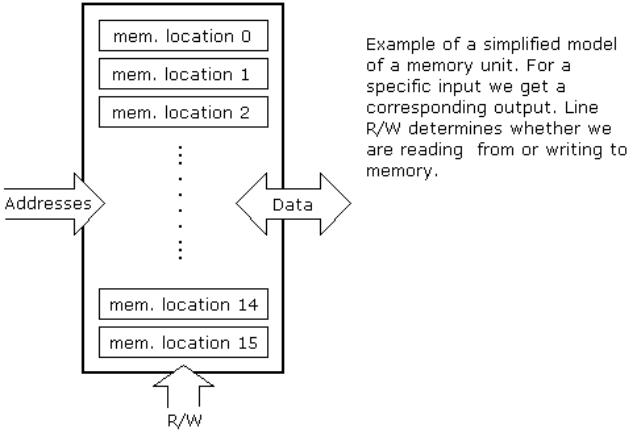
Chapter 1 - Introduction to Microprocessors
Memory components are exactly like that. For a certain input we get the contents of a certain addressed memory location and that's all. Two new concepts are brought to us: addressing and memory location. Memory consists of all memory locations, and addressing is nothing but selecting one of them. This means that we need to select the desired memory location on one end, and on the other end we need to wait for the contents of that location. Beside reading from a memory location, memory must also provide for writing onto it. This is done by supplying an additional line called control line. We will designate this line as R/W (read/write). Control line is used in the following way: if r/w=1, reading is done, and if opposite is true then writing is done on the memory location. Memory is the first element, and we need a few others in order for our microcontroller to work.
1.2 Central Processing Unit
Let's add 3 more memory locations to a specific block that will have a built in capability to multiply, divide, subtract, and move its contents from one memory location onto another. The part we just added in is called "central processing unit" (CPU). Its memory locations are called registers.
http://www.mikroelektronika.co.yu/english/books/1_Poglavlje.htm (4 of 12) [30/12/2001 16:53:23]
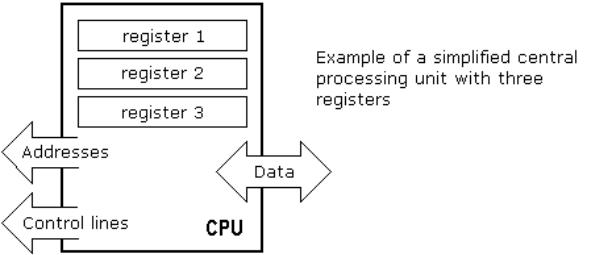
Chapter 1 - Introduction to Microprocessors
Registers are therefore memory locations whose role is to help with performing various mathematical operations or any other operations with data wherever data can be found. Lets look at the current situation. We have two independent entities (memory and CPU) which are interconnected, and thus any exchange of data is hindered, as well as its functionality. If, for example, we wish to add the contents of two memory locations and return the result again back to memory, we will need a connection between memory and CPU. Simply stated, we must have some "way" through which data goes from one block to another.
1.3 Bus
That "way" is called "bus". Physically, it represents a group of 8, 16, or more wires
There are two types of buses: address and data bus. The first one consists of as many lines as the amount of memory we wish to address, and the other one is as wide as data, in our case 8 bits or the connection line. First one serves to transmit address from CPU memory, and the second to connect all blocks inside the microcontroller.
http://www.mikroelektronika.co.yu/english/books/1_Poglavlje.htm (5 of 12) [30/12/2001 16:53:23]
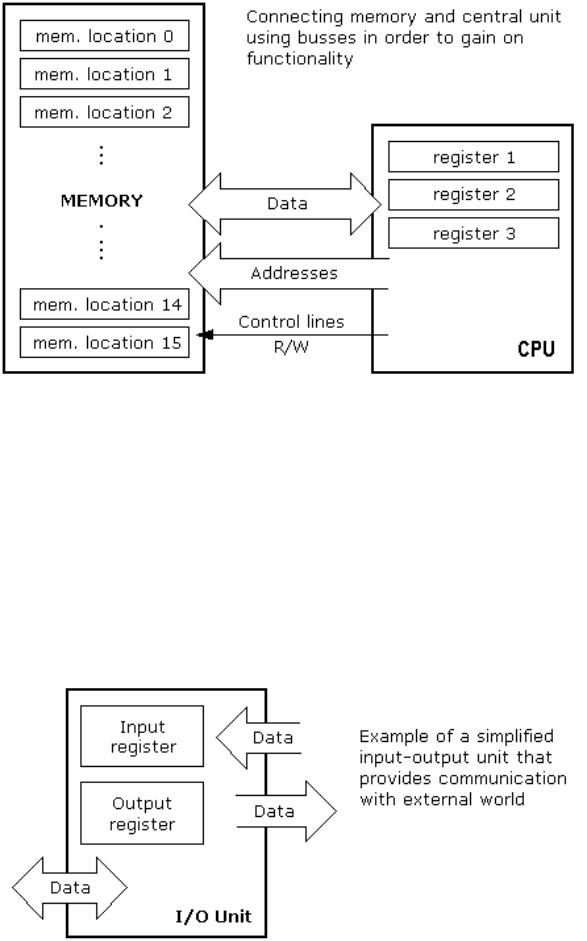
Chapter 1 - Introduction to Microprocessors
As far as functionality, the situation has improved, but a new problem has also appeared: we have a unit that's capable of working by itself, but which does not have any contact with the outside world, or with us! In order to remove this deficiency, let's add a block which contains several memory locations whose one end is connected to the data bus, and the other has connection with the output lines on the microcontroller which can be seen with the naked eye as pins on the electronic component.
1.4 Input-output unit
Those locations we've just added are called "ports". There are several types of ports : input, output or two-way ports. When working with ports, first of all it is necessary to choose which port we need to work with, and then to send data to, or take it from the port.
http://www.mikroelektronika.co.yu/english/books/1_Poglavlje.htm (6 of 12) [30/12/2001 16:53:23]

Chapter 1 - Introduction to Microprocessors
When working with it the port acts like a memory location. Something is simply being written into or read from it, and it is possible to easily register that on the pins of the microcontroller.
1.5 Serial communication
With this we've added to the already existing unit the possibility of communication with an outside world. However, this way of communicating has its drawbacks. One of the basic drawbacks is the number of lines which need to be used in order to transfer data. What if it is being transferred to a distance of several kilometers? The number of lines times number of kilometers doesn't promise the economy of the project. It leaves us having to reduce the number of lines though in such a way that we don't lessen its functionality. Suppose we are working with three lines only, and that one line is used for sending data, other for receiving, and the third one is used as a reference line for both the input and the output side. In order for this to work, we need to set the rules of exchange of data. These rules are called protocol. Protocol is therefore defined in advance so there wouldn't be any misunderstanding between the sides that are communicating with each other. For example, if one man is speaking in French, and the other in English, it is highly unlikely that they will quickly and effectively understand each other. Let's suppose we have the following protocol. The logical unit "1" is set up on the transmitting line until transfer begins. Once the transfer starts, we lower the transmission line to logical "0" for a period of time (which we will designate as T), so the receiving side will know that it is receiving data, and so it will activate its mechanism for reception. Let's go back now to the transmission side and start putting logic zeros and ones onto the transmitter line in the order from a bit of the lowest value to a bit of the highest value. Let each bit stay on line for a time period which is equal to T, and in the end, or after the 8th bit, let us bring the logical unit "1" back on the line which will mark the end of the transmission of one data. The protocol we've just described is called in professional literature NRZ (Non-Return to Zero).
As we have separate lines for receiving and sending, it is possible to receive and send data (info.) at the same time. Block which enables this way of communication is called a serial communication block. Unlike the parallel transmission, data moves here bit by bit, or in a series of bits which is where the name serial communication comes from. After the reception of data we need to read it from the transmitting location and store it in memory as opposed to sending where the process is reversed. Data goes from memory through the bus to the sending location, and from there to the receiving unit according to the protocol.
http://www.mikroelektronika.co.yu/english/books/1_Poglavlje.htm (7 of 12) [30/12/2001 16:53:23]
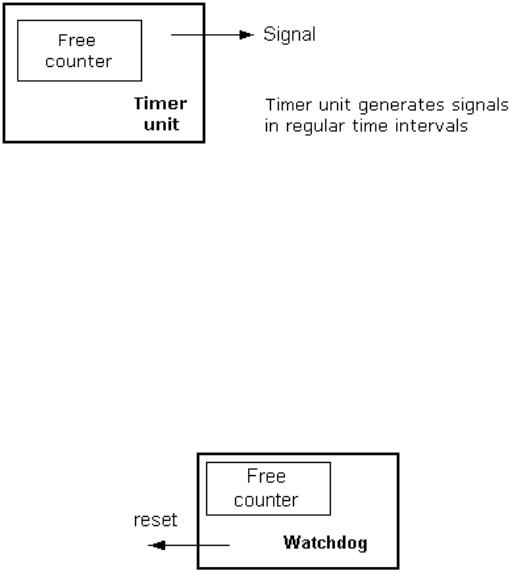
Chapter 1 - Introduction to Microprocessors
1.6 Timer unit
Now that we have the serial communication down, we can receive, send and process data.
However, for us to be able to utilize it in industry we need a few more blocks. One of those is the timer block which is significant to us because it can give us information about time, duration, protocol etc. The basic unit of the timer is a free counter which is in fact a register whose numeric value increases in even intervals, so that by taking its value during periods T1 and T2 and on the basis of their difference we can determine how much time has elapsed. This is a very important part of the microcontroller whose mastery requires most of our time.
1.7 Watchdog
One more thing requiring our attention is a flawless performance of the microcontroller
during its use. Suppose that as a result of some interference (which often does occur in industry) our microcontroller stops executing the program, or worse, it starts working incorrectly.
Of course, when this happens with a computer, we simply reset it and it will keep working. However, there is no reset button we can push on the microcontroller and thus solve our problem. To overcome this obstacle, we need to introduce one more block called watchdog. This block is in fact another free counter where our program needs to write a zero in every time it executes correctly. In case that program gets "stuck", zero will not be written in, and counter alone will reset the microcontroller upon obtaining its maximum value. This will result in running the program again, and correctly this time around. That is an important element of every program that needs to be reliable without man's supervision.
1.8 Analog-Digital Converter
As the peripheral signals are substantially different from the ones that microcontroller can understand (zero and one), they have to be converted into a mode which can be
http://www.mikroelektronika.co.yu/english/books/1_Poglavlje.htm (8 of 12) [30/12/2001 16:53:23]

Chapter 1 - Introduction to Microprocessors
comprehended by a microcontroller. This task is performed by a block for analog-digital conversion or by an AD converter. This block is responsible for converting an information about some analog value to a binary number and for follow it through to a CPU block so that CPU block can further process it.
Thus, the microcontroller is now finished, and all that is left now is to put it into an electronic component where it will access inner blocks through the pins of this component. The picture below shows what a microcontroller looks like inside.
Physical configuration of the interior of a microcontroller
Thin lines which lead from the center towards the sides of the microcontroller represent wires connecting inner blocks with the pins on the housing of the microcontroller. Chart on the following page represents the center section of a microcontroller.
http://www.mikroelektronika.co.yu/english/books/1_Poglavlje.htm (9 of 12) [30/12/2001 16:53:23]
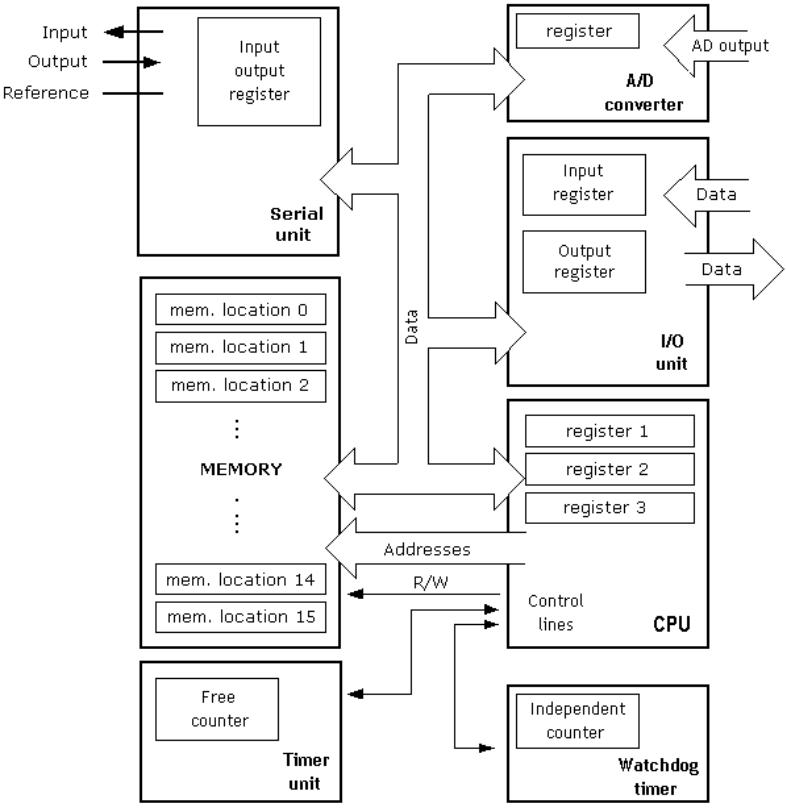
Chapter 1 - Introduction to Microprocessors
Microcontroller outline with its basic elements and internal connections
For a real application, a microcontroller alone is not enough. Beside a microcontroller, we need a program that will execute, and a few more elements which make up a interface logic towards the elements of regulation (which will be discussed in later chapters).
http://www.mikroelektronika.co.yu/english/books/1_Poglavlje.htm (10 of 12) [30/12/2001 16:53:23]

Chapter 1 - Introduction to Microprocessors
1.9 Program
Program writing is a special field of work with microcontrollers and is called "programming". Lets try writing a small program in a language that we will make up ourselves and that everyone will be able to understand.
START
REGISTER1=MEMORY LOCATION_A
REGISTER2=MEMORY LOCATION_B
PORTA=REGISTER1 + REGISTER2
END
The program adds up the contents of two memory locations, and views their total on port A. The first line of the program stands for moving the contents of memory location "A" into one of the registers of central processing unit. As we need the other data as well, we will also move it into the other register of the central processing unit. The next instruction instructs the central processing unit to add up the contents of those two registers and send a result obtained to port A, so that sum of that addition would be visible to the outside world. For a more complex problem, program that works on its solution will be bigger.
Programming can be done in several languages such as Assembler, C and Basic which are most commonly used languages. Assembler belongs to lower level languages that are programmed slowly, but take up the least amount of space in memory and gives the best results where the speed of program execution is concerned. As it is the most commonly used language in programming microcontrollers it will be discussed in a later chapter. Programs in C language are easier to be written, easier to be understood, but are slower in executing from assembler programs. Basic is the easiest one to learn, and its instructions are nearest a man's way of reasoning, but like C programming language it is also slower than assembler. In any case, before you make up your mind about one of these languages you need to consider carefully the demands for execution speed, for the size of memory and for the amount of time available for its assembly. After the program is written, we need to install the microcontroller into a device and let it work. In order to do this we need to add a few more external components necessary for its work. First we must give life to a microcontroller by connecting it to a supply (voltage needed for operation of all electronic instruments) and oscillator whose role is similar to the role that heart plays in a human body. Based on its clocks microcontroller executes instructions of a program. As it receives supply microcontroller will perform a small check up on itself, look up the beginning of the program and start executing it. How the device will work depends on many parameters, the most important of which is the skillfulness of the developer of hardware, and on programmer's expertise in getting the maximum out of the device with his program.
http://www.mikroelektronika.co.yu/english/books/1_Poglavlje.htm (11 of 12) [30/12/2001 16:53:23]
Chapter 1 - Introduction to Microprocessors
© Copyright 1999. mikroElektronika. All Rights Reserved. For any comments contact webmaster.
http://www.mikroelektronika.co.yu/english/books/1_Poglavlje.htm (12 of 12) [30/12/2001 16:53:23]
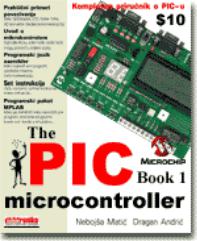
magazine mikroElektronika - Magazin za primenjenu elektroniku, automatiku i programiranje
PIC microcontrollers for beginners,too!
Authors: Nebojsa Matic and Dragan Andric
Paperback - 252 pages (May 15, 2000)
Dimension(May. 75achs)s:)Tj /T40 1 Tf 9.871 0 0 9.871321.16 18 629.8597 T
magazine mikroElektronika - Magazin za primenjenu elektroniku, automatiku i programiranje
Microcontrollers versus microprocessors
1.1 Memory unit
1.2 Central processing unit
1.3 Buses
1.4 Input-output unit
1.5 Serial communication
1.6 Timer unit
1.7 Watchdog
1.8 Analog-digital converter
1.9 Program
CHAPTER II MICROCONTROLLER PIC16F84
Introduction
CISC, RISC
Applications
Clock/instruction cycle
Pipelining
Meaning of pins
2.1 Clock generator - oscillator
2.2 Reset
2.3 Central processing unit
2.4 Ports
2.5 Memory organization
2.6 Interrupts
2.7 Free timer TMR0
2.8 EEPROM Data memory
CHAPTER III INSTRUCTION SET
Introduction
Instruction set in PIC16Cxx microcontroller family Data Transfer
Arithmetic and logic Bit operations
Directing the program flow Instruction execution period Word list
http://www.mikroelektronika.co.yu/english/books/0_Uvod.htm (2 of 6) [30/12/2001 16:53:26]
magazine mikroElektronika - Magazin za primenjenu elektroniku, automatiku i programiranje
CHAPTER IV ASSEMBLY LANGUAGE PROGRAMMING
Introduction
Sample of a written program
Control directives
●4.1 define
●4.2 include
●4.3 constant
●4.4 variable
●4.5 set
●4.6 equ
●4.7 org
●4.8 end
Conditional instructions
●4.9 if
●4.10 else
●4.11 endif
●4.12 while
●4.13 endw
●4.14 ifdef
●4.15 ifndef
Data directives
●4.16 cblock
●4.17 endc
●4.18 db
●4.19 de
●4.20 dt
Configurating a directive
●4.21 _CONFIG
●4.22 Processor
Assembler arithmetic operators
Files created as a result of program translation Macros
http://www.mikroelektronika.co.yu/english/books/0_Uvod.htm (3 of 6) [30/12/2001 16:53:26]
magazine mikroElektronika - Magazin za primenjenu elektroniku, automatiku i programiranje
CHAPTER V MPLAB
Introduction
5.1 Installing the MPLAB program package
5.2 Introduction to MPLAB
5.3 Choosing the development mode
5.4 Designing a project
5.5 Designing new assembler file
5.6 Writing a program
5.7 MPSIM simulator
5.8 Toolbar
CHAPTER VI SAMPLES
Introduction
6.1 Supplying the microcontroller
6.2 Macros used in programs
●Macros WAIT, WAITX
●Macro PRINT
6.3 Samples
●LED diodes
●Keyboard
●Optocoupler
Optocouplering the input lines
Optocouplering the output lines
●Relays
●Generating a sound
●Shift registers
Input shift register
Output shift register
●7-segment Displays (multiplexing)
●LCD display
●12-bit AD converter
●Serial communication
APPENDIXES
http://www.mikroelektronika.co.yu/english/books/0_Uvod.htm (4 of 6) [30/12/2001 16:53:26]
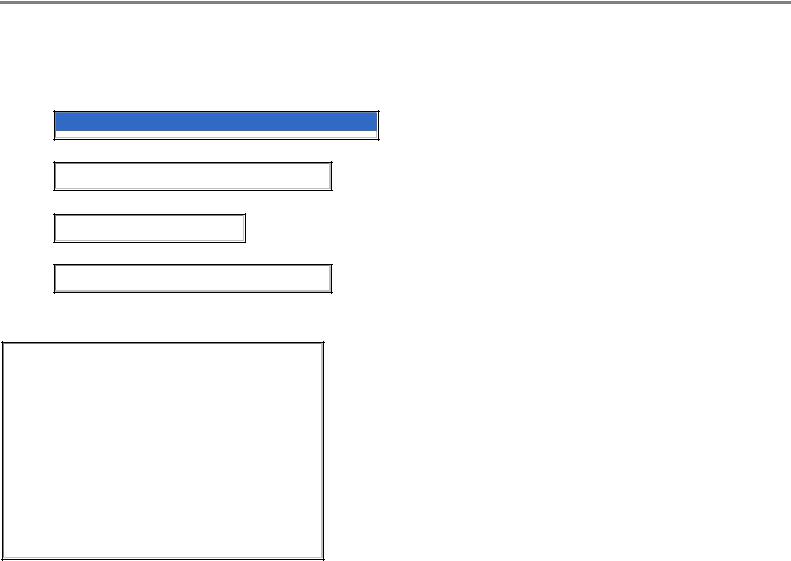
magazine mikroElektronika - Magazin za primenjenu elektroniku, automatiku i programiranje
APPENDIX A INSTRUCTION SET
APPENDIX B NUMERIC SYSTEMS
Introduction
B.1 Decimal numeric system
B.2 Binary numeric system
B.3 Hexadecimal numeric system
Conclusion
APPENDIX C GLOSSARY
Send us a comment about a book
Subject :
Cooment about book PIC microcontrollers
Name :
State :
USA
E-mail :
Your message:
http://www.mikroelektronika.co.yu/english/books/0_Uvod.htm (5 of 6) [30/12/2001 16:53:26]

magazine mikroElektronika - Magazin za primenjenu elektroniku, automatiku i programiranje
Submit Reset
| Index | What's new | New issue | Old issues | Advertising | Download | Club mikroElektronika | Articles | Development tools | Books | Link page | About us | WebForce | Contact |
© Copyright 2001. mikroElektronika. All Rights Reserved. For any comments contact webmaster.
http://www.mikroelektronika.co.yu/english/books/0_Uvod.htm (6 of 6) [30/12/2001 16:53:26]
